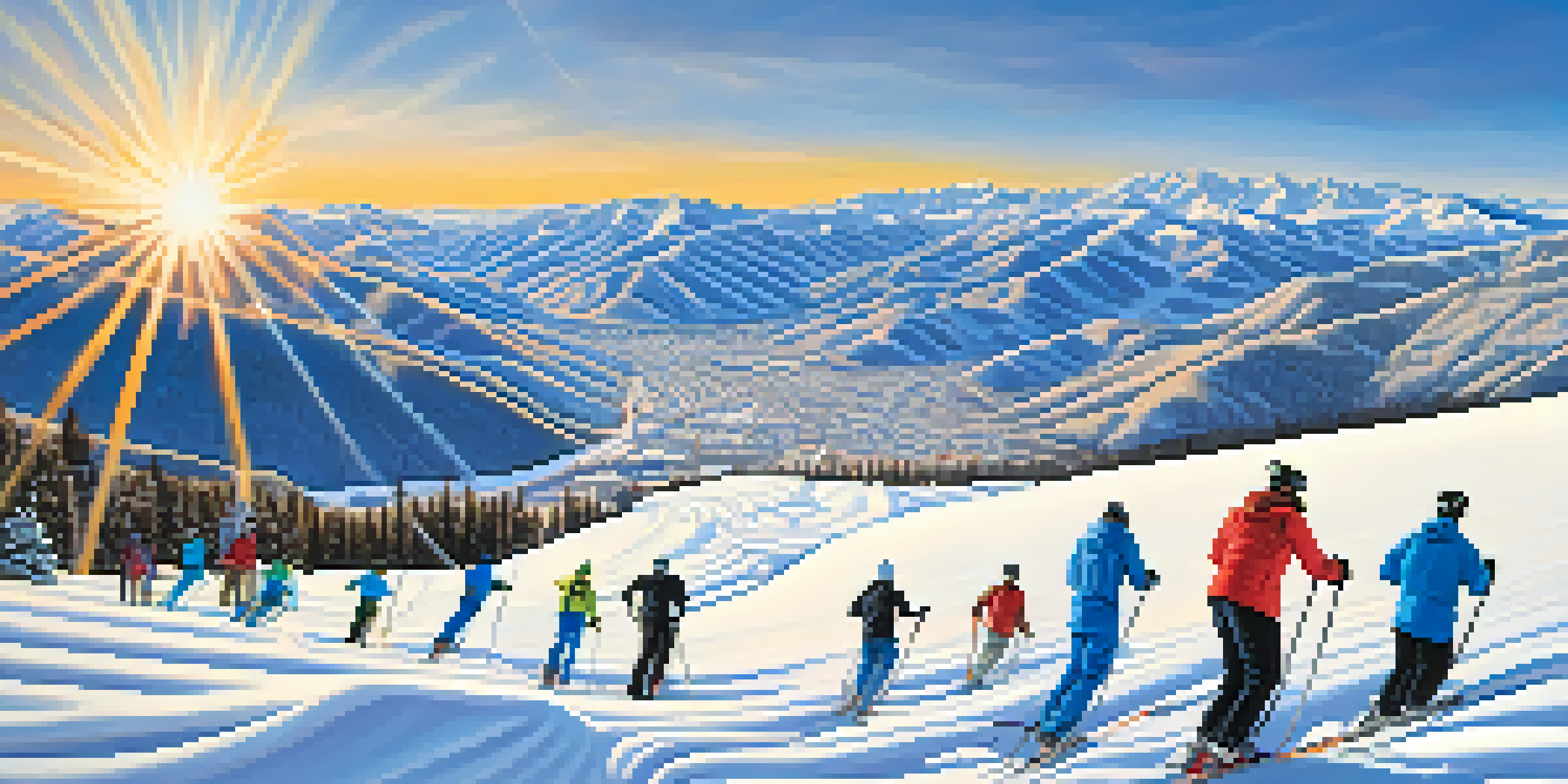Understanding Utah's Seasonal Weather Patterns and Trends

An Overview of Utah's Unique Climate Zones
Utah's climate is as diverse as its landscape, which includes mountains, deserts, and plateaus. This variety means that different parts of the state experience distinct weather patterns. For instance, the northern regions, like Salt Lake City, have a more humid continental climate, while the southern areas, such as St. George, tend to be arid and dry.
Climate change is no longer some far-off problem; it is happening here, it is happening now.
The state's elevation plays a significant role in its weather. Higher elevations can lead to cooler temperatures and increased snowfall in the winter, creating popular ski resorts. Meanwhile, the valleys and lower elevations can experience sweltering summers, making it crucial for residents to prepare for extreme temperature swings.
Understanding these climate zones helps residents and visitors alike plan outdoor activities throughout the year. Whether you're hiking in the summer or skiing in the winter, knowing what to expect can enhance your experience in Utah's beautiful landscapes.
Winter Weather: Snowfall and Cold Temperatures
Utah is renowned for its winter weather, particularly its snowfall. The state's mountainous regions, especially the Wasatch Range, receive significant snowfall, often making it a top destination for skiing and snowboarding. The snowpack in these areas is crucial for water resources during the warmer months, as it melts to feed rivers and reservoirs.

Cold temperatures can also be a defining feature of Utah's winters. From December to February, residents often experience frigid mornings and chilly nights. However, sunny days are common, providing a refreshing contrast to the cold, and giving rise to the term 'Greatest Snow on Earth' used to describe Utah's ski conditions.
Utah's Diverse Climate Zones
Utah's varied elevation creates distinct climate zones, influencing weather patterns from humid conditions in the north to arid areas in the south.
Understanding winter weather in Utah is essential for safety and preparation. Whether driving in snowy conditions or dressing appropriately for outdoor activities, being informed can lead to a more enjoyable winter experience.
Spring: A Transition of Weather Patterns
Spring in Utah is a time of transition, where the cold grip of winter gradually gives way to warmer temperatures. Typically starting in March and lasting until late May, this season can bring a mix of weather conditions, including rain, sunshine, and even late snowstorms. This unpredictability keeps residents on their toes and encourages them to be prepared for anything.
The environment is where we all meet; where we all have a mutual interest; it is the one thing all of us share.
As the snow melts, rivers and streams swell, providing vital water resources for the state. Spring is also a beautiful time to witness wildflowers blooming and trees budding, making it a favorite season for outdoor enthusiasts and photographers alike. The contrast of lingering snow in the mountains with vibrant greenery in the valleys is a sight to behold.
Planning spring activities can be tricky, given the fluctuating weather. However, it's the perfect time for hiking, biking, and enjoying the blossoming landscapes, as long as you're ready for quick weather changes.
Summer: Heat Waves and Thunderstorms
Summer in Utah, spanning from June to August, is characterized by hot temperatures, particularly in the southern regions. Cities like St. George can reach scorching highs, often exceeding 100°F. This heat draws many residents to the mountains, where cooler temperatures provide a refreshing escape from the summer sun.
Thunderstorms are also common during the summer months, especially in the late afternoon and evening. These storms can bring much-needed rain but can also lead to flash flooding in areas with dry desert soil. Knowing how to stay safe during these storms is crucial, particularly for those engaging in outdoor activities.
Seasonal Weather Challenges
Each season in Utah presents unique weather challenges, making preparation and awareness essential for residents and outdoor enthusiasts.
To make the most of summer in Utah, it's essential to plan your activities around the heat and unpredictable weather. Early morning or late evening outings can be more enjoyable and safer, allowing you to experience all that Utah has to offer without the sweltering heat.
Fall: Stunning Colors and Cooler Days
Fall in Utah is nothing short of spectacular, with vibrant foliage painting the landscape in shades of red, orange, and yellow. This season typically runs from September to November and brings cooler temperatures, making it a delightful time for outdoor activities like hiking and camping. The crisp air and beautiful scenery draw visitors from near and far.
As temperatures begin to drop, Utahns often prepare for the impending winter. This transition period can also bring unpredictable weather, including sudden cold snaps or early snowfall. Understanding these patterns can help residents manage their preparations effectively, whether it's winterizing their homes or adjusting their wardrobes.
Fall is also a time for harvest festivals and outdoor events, making it a popular season for families and friends to gather. Whether you're exploring a pumpkin patch or enjoying a scenic drive through the canyons, the beauty of Utah in the fall is truly a sight to behold.
Climate Change: Effects on Utah's Weather
Climate change has become a pressing issue affecting weather patterns across the globe, and Utah is no exception. Rising temperatures and shifting precipitation patterns have resulted in changes to Utah's seasonal weather, including warmer winters and drier summers. Understanding these changes is essential for residents and policymakers alike.
One significant impact is the increased frequency of droughts and wildfires during the summer months. These conditions can threaten water supplies and ecology, making it crucial for communities to adapt to evolving weather patterns. Awareness and education about these issues can help residents take proactive measures to reduce their environmental footprint.
Impact of Climate Change
Climate change is altering Utah's weather, leading to warmer winters and drier summers, which pose challenges like droughts and wildfires.
As we continue to navigate the effects of climate change, it's vital to support sustainable practices and policies. By participating in local conservation efforts and advocating for environmental responsibility, Utahns can help mitigate the impact of these changes on their beautiful state.
Preparing for Seasonal Weather Changes
Being aware of Utah's seasonal weather patterns is key to staying safe and making the most of outdoor activities. Each season brings unique challenges and opportunities, so preparation is vital. This can include having the right gear, such as snow tires for winter or sunscreen for summer hikes.
Additionally, keeping an eye on local forecasts can help you stay informed about sudden weather changes. Many residents find it helpful to use weather apps or services that provide up-to-date information about temperature fluctuations and storm predictions. This knowledge allows for better planning and decision-making.

Ultimately, embracing Utah's diverse weather can lead to memorable experiences. Whether you're skiing on a powder day or enjoying a warm summer evening, being prepared ensures you can enjoy all that Utah has to offer, no matter the season.